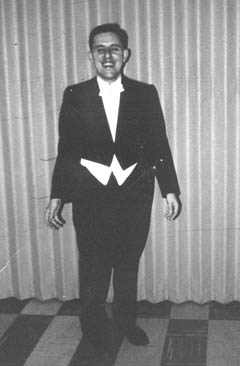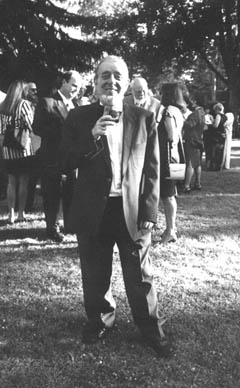The church was the most important
place that the Italians had. There they received almost all the help
they needed. After the urban renewal took place many Italians moved
from this area. However, many of them continued coming back to the
Church of St. Anthony
even though they lived a great distance from it.
In terms of the Procession of St.
Anthony (which is part of St.
Anthony’s Feast), it started the same year the church was
built, but it stopped during the war years. It has gotten bigger and
bigger every year. Now it draws about 10,000 people.
Q: How important is the Church
of St. Anthony today?
A: Oh, it is still very important. One of the reasons is the family
spirit that still lives on in Italian families. Children of Italian
descent respect their nonni [grandfather or ancestors]. They
are becoming more and more Canadian but they are still trying to keep
their Italian roots and the church plays an important role in that.
Q: You were in the church
when the artist Guido
Nincheri, who drew the architectural plan of St.
Anthony’s Church, was working there. What was he like?
A: He was a fragile little man who would work at night. He spent
one year working on the frescoes for the apse and on the stained-glass
windows. There was wooden scaffolding constructed for him. He did
not have any assistants; he did almost everything by himself. Father
Jerome and the Licari brothers helped him in preparation of the
walls for the frescoes.
I also remember that he worked from
live models for some of his work.
Q: Can you recall any interesting
stories while working as an interpreter at the courts?
A: I remember well my first
case. A woman was accused of shoplifting. She had several items
in her bag. Some of them had the labels, others did not. The judge
wanted to charge her for all of them but I said that we could not
prove if the woman stole every single item because some of the articles
did not have labels. After a long discussion the judge started giving
up. He said to me: “Could you ask her why she took all those
things without paying for them?” When I asked the woman the
same question she answered that she thought she had to pay at the
bank. “O.K.,” said the judge. “I will suspend
the sentence, but tell her that next time she has to pay at the
store.”
There were also some sad stories.
An undercover policeman went to the home of an eighty-year-old lady
and sold her a bottle of homemade alcohol. A few days later she
was charged with possession of alcohol. I tried to explain that
in Europe it was a normal thing to buy alcohol like that and keep
it in the home for guests and that she did not buy it to resell
it. It did not help. In the end she had to pay $100.
Q: Do you remember any popular
faces or people who helped the new immigrants in early years?
A: Many Italians found work at Galla
Bakery, O’Leary Asphalt Construction and Caravata Tailoring.
Those who were good at plaster work were employed by the Licari brothers
and the Zito family, while Durie Mosaic
gave jobs to marble workers.
I also remember Chappie’s
restaurant and the one run by the Imbro brothers on Rideau Street.
Those were the best spaghetti places in town.
There was the Prescott Hotel, which
Antonio Disipio bought in 1930 and is now owned by his grandson, and
Guzzo and Adamo Specialty Shop. I also remember the post office run
by Mrs. Tiezzi. She
and her husband helped a lot of new immigrants.
In terms of prominent people, there
was Dr. Sabetta, a skin specialist. Also Lina Cuccaro and Jennie
Prosperine. Lina worked at the embassy at the time. Both she and
Jennie Prosperine were presidents
of the Ladies’ Aid. Then, Mary Ierullo,
Guiseppe Constantini, the Honourable George McIlraith and many others.
Q: If you had the power
to change something in today’s Italian-Canadian community,
what would you change?
A: I would like to see people working more together as it was the
case in the early years. They should also work more on the preservation
of the Italian language and culture and give more support to the places
that are the pride of the community, such as the Villa
Marconi Long-term Care Centre.
I would also like to thank the Servite
Fathers and St. Anthony’s
Church for giving me the opportunity to achieve many goals, not
only community wise but also spiritually.


